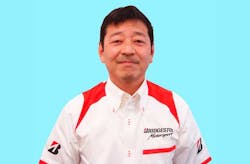By Neal Weingart
This season marks the end of Bridgestone's participation as the Official Tire Supplier to MotoGP. It is a time for reflection on a commitment spanning 14 years and MTD is pleased to bring you this interview with the man at the heart of this story, Hiroshi Yamada.
Yamada-san, it has been a long journey for Bridgestone's participation in the MotoGP class, what has been your role in this journey?
I have been involved in Grand Prix racing since 1991 when Bridgestone supported riders in the 125cc class. At this time I worked as the Motorcycle Racing Coordinator for Bridgestone and then became Manager of Motorcycle Racing in 2001, coinciding with the preparations for our entry into the MotoGP class in 2002. In 2007 I became Manager of the Motorsport Department, a role I still hold today and I am responsible for overseeing all two-wheeled racing projects including MotoGP, the All-Japan Road Racing and MX championships and the Asia Talent Cup. I also manage our involvement as a tire supplier at the Suzuka 8 Hour, one of the few international motorcycle races where tire manufacturers still go head-to-head in competition. This year Bridgestone will be aiming to extend our record at the 8 Hour to ten consecutive victories as a tire supplier.
Bridgestone had been involved in car motorsports before it entered the MotoGP arena in 2002. How different was it to create tires for Grand Prix motorcycles compared to racing cars?
There are some fundamental aspects of tire design that apply to both car and motorcycle racing, but in some ways motorcycle tire design is more demanding. Comparatively speaking, each square centimeter of surface patch on a MotoGP tire has to transmit more power to the tarmac than an F1 tire. This power has to be transmitted in a controllable away to ensure rider safety and so we need to constantly develop our tires to match the technical evolution of the latest MotoGP machines.
2004 brought Bridgestone's first MotoGP victory but also challenges such as Shinya Nakano's high-speed accident due to tire delamination at Mugello. How did these events shape the Bridgestone racing program and what lessons were drawn for these experiences?
Our first victory was a milestone for us and I think it really made everyone appreciate the potential of our race tires. When other teams saw we could deliver race-winning performance, I think for the first time in a long time they saw there was more than one tire supplier in MotoGP who was operating at the highest level. As for the incident at Mugello, this was unfortunate but it was a valuable learning experience and after this we were able to ensure such an event never happened again. It took a lot of hard work to restore our reputation, but I am proud that for many years Bridgestone race tires have had an excellent reputation for their consistency and quality thanks to our ongoing technical development.
2005 was the year Bridgestone teamed up with Ducati in MotoGP. How did this relationship develop and result in Bridgestone and Ducati's first MotoGP World Championship in 2007?
Forging a partnership with Ducati was very important for us. At the time we were working with the Kawasaki and Suzuki teams, so partnering with another strong team really helped accelerate our rate of tire development. In 2005 we scored eight podiums, and the next year we were on the podium 11 times including four victories, so having three factory teams to develop our tires, the benefit was immediate. The partnership with Ducati continued to grow and in 2007 culminated in a first MotoGP World Championship for both us and Ducati with Casey Stoner. This was the realization of a goal that we set out for ourselves since entering the premier class; to prove we were the best motorcycle tire supplier in MotoGP.
2008 was a transitional year for MotoGP with new tire requirements reshaping alliances. Please tell us about the relationship between the competing tire manufacturers and Dorna (commercial rights holder for the FIM Road Racing World Championship Grand Prix) during this highly charged period.
Our first title success in 2007 resulted in some riders, including Valentino Rossi, switching to Bridgestone at the start of 2008. In the few years leading up to 2008, the number of tires each supplier could provide to a rider had been reduced year-on-year, but in 2008 following a request from Michelin, there was an increase in the number of tires given to each rider. In 2007, each rider could get 31 slick tires, and this number was increased to 40 slicks per rider for the 2008 season.
Despite this change, we were able to win a second consecutive championship as a tire supplier with Rossi in 2008, at which point even more teams wanted to switch to our product. At the time we would have liked to have continued in a tire competition situation, but with so many teams wanting to change to Bridgestone, Dorna made the decision to go down the sole tire supplier route. It was an end of an era, but also provided our company with an exciting new challenge.
This concludes Part 1 of the interview. In Friday's Part 2 Yamada-san talks about the present era of a single tire supplier in MotoGP and the 2015 race season.
To read Part 2, click here.



